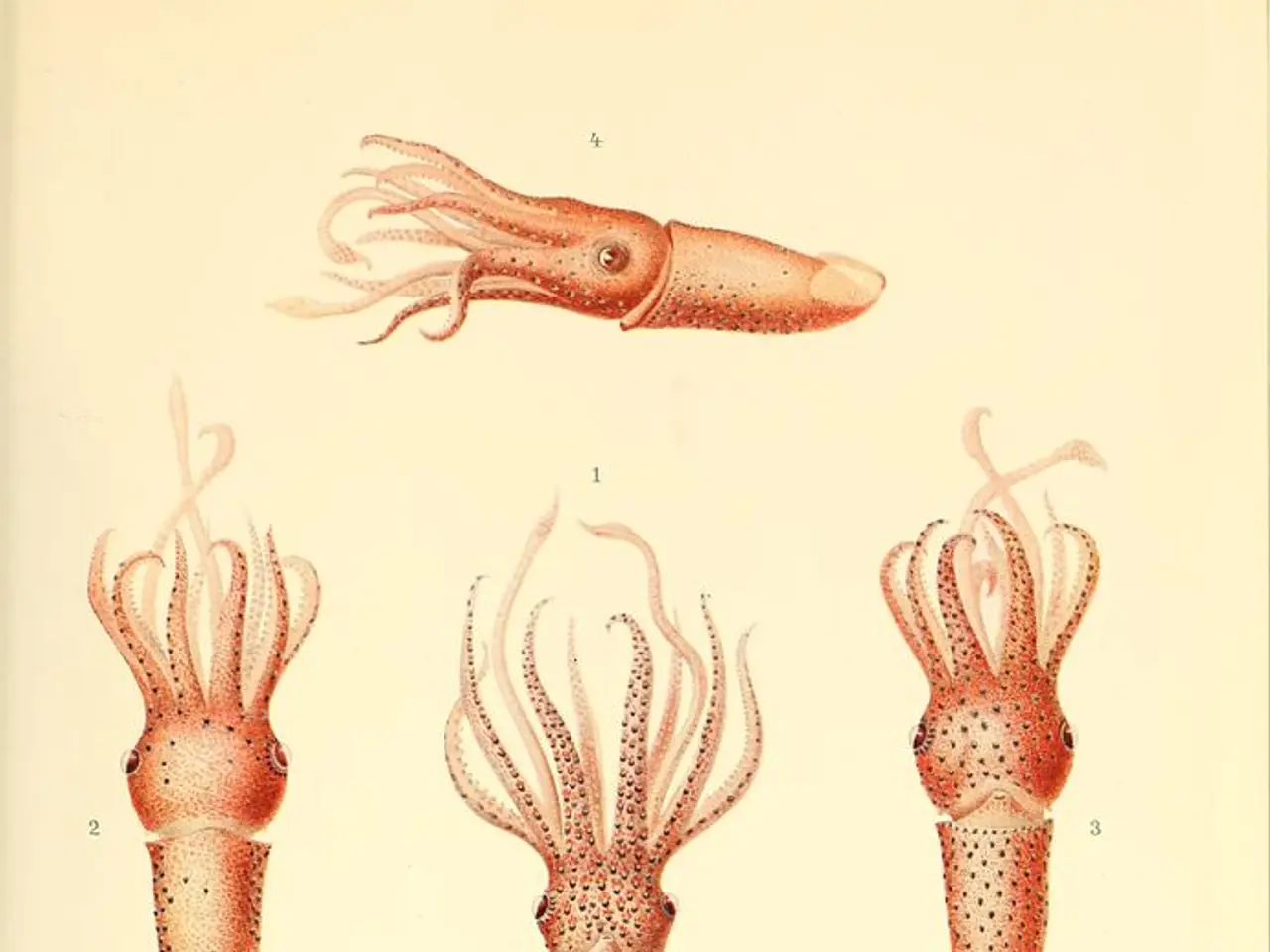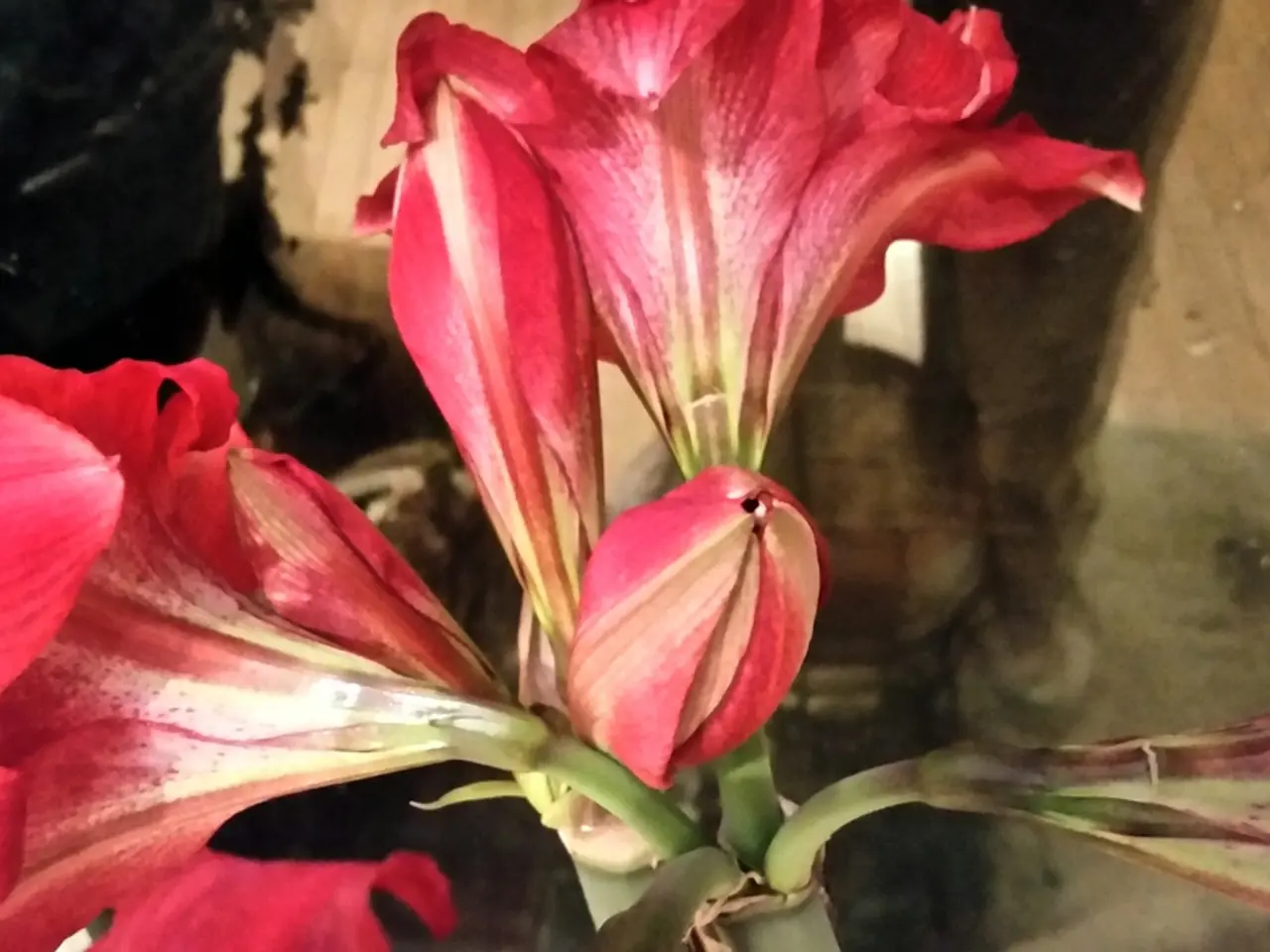Bizarre Ocean Octopuses: A Catalog of 10 Strange Specimens
Octopuses, with their intriguing appearance and extraordinary abilities, have long captivated the imagination of marine biologists and divers alike. Here are ten remarkable octopus species, each with its own unique features that make them stand out in the vast ocean.
Giant Pacific Octopus (Enteroctopus dofleini)
The Giant Pacific Octopus holds the title of the largest octopus species, with an arm span over 4 meters and a weight of around 50 kg. This colossal creature boasts nine brains (one central brain plus a mini-brain in each arm), three hearts, a venomous beak, and specialized color-changing skin cells for camouflage. Known for its hunting prowess, it even targets sharks at night and inhabits both deep and shallow waters [1].
Blanket Octopus (Genus Tremoctopus)
The Blanket Octopus is renowned for its stunning, see-through webbing connecting the arms of females, which resembles a flowing blanket or fancy gown. With four species existing, they tend to live in the open ocean, making sightings rare and prized among divers [2].
Mimic Octopus (Thaumoctopus mimicus)
The Mimic Octopus is famous for its ability to imitate up to 15 different marine animals, including lionfish, sea snakes, flatfish, jellyfish, crabs, and anemones. This chameleon of the sea changes its behavior and appearance dynamically depending on the threat nearby, making it a master of disguise [5].
Dumbo Octopus (Genus Grimpoteuthis)
Named after the Disney character "Dumbo" because of its ear-like fins protruding from the mantle, the Dumbo Octopus lives in extreme deep-sea environments and has a gelatinous body adapted for life under high pressure.
Blue-Ringed Octopus (Genus Hapalochlaena)
The Blue-Ringed Octopus is a small but highly venomous species that displays bright blue rings when threatened. Its venom contains tetrodotoxin, capable of fatal neurotoxicity to humans.
Common Octopus (Octopus vulgaris)
The Common Octopus is widely studied for its intelligence, problem-solving, and complex behaviors. It uses rapid camouflage through chromatophores to blend into environments.
Flapjack Octopus (Opisthoteuthis californiana)
The Flapjack Octopus has a rounded, flat body and webbed arms that give it a "flapjack"-like appearance. A deep-sea species known for its slow swimming and unusual look, it is a common sight in marine biology.
Atlantic White-Spotted Octopus (Callistoctopus macropus)
Recognized by striking white spots on its reddish-orange body and its long arms, the Atlantic White-Spotted Octopus exhibits cunning hunting tactics and foraging behavior.
Venus Flying Squid (Technically a squid, but sometimes confused with octopuses)
The Venus Flying Squid, though not an octopus, is worth mentioning as it shares some characteristics with octopuses and is often mistaken for one.
Starry Night Octopus (Octopus cyanea)
Featuring iridescent blue spots scattered across its body, the Starry Night Octopus is known for its agility and active hunting.
The top unique features highlighted among these octopuses include advanced camouflage techniques (color and texture change), mimicry to imitate other animals for defense, enormous size and strength in giants, deep-sea adaptations, venom potency, and extraordinary intelligence manifesting in problem-solving and tool use [1][2][4][5].
For those interested in specific aspects of octopuses, such as size, habitat, behavior, or novelty, I can provide more detailed profiles or fewer/more species tailored to your preferences. For example, the Star-sucker Pygmy Octopus, one of the smallest known species, lives in the Pacific Ocean and has a complex nervous system and problem-solving skills. Female Ghost Octopuses guard their egg clutches for years without eating, demonstrating extreme maternal devotion. The Blanket Octopus can unfurl its tissue to appear larger to potential predators and can even detach it completely as a diversion when things get dicey. It is also immune to Portuguese man-o'-war stings and has been caught stealing tentacles from these venomous jellies to use as weapons against their own enemies. The Ghost Octopus, recently spotted near Hawaii, has a pale, almost see-through body and hangs out in the pitch-black depths. The Dorado Octopus, discovered off the coast of Costa Rica, thrives in a harsh environment near underwater volcanic vents and broods its eggs near hydrothermal springs.
- The fascination with octopuses extends beyond marine biologists and divers, as their unusual appearance and extraordinary abilities capture the imagination of many.
- Besides their size, habitat, behavior, and novelty, some unique features of octopuses include advanced camouflage techniques, mimicry, and intelligence.
- The Giant Pacific Octopus, the largest octopus species, weighs around 50 kg and boasts nine brains, three hearts, and specialized color-changing skin cells.
- The Blanket Octopus is renowned for its four species and its see-through webbing that resembles a flowing blanket or fancy gown in females.
- The Mimic Octopus is famous for its ability to imitate up to 15 different marine animals, making it a master of disguise.
- Named after Disney's Dumbo, the Dumbo Octopus lives in extreme deep-sea environments and has a gelatinous body adapted for life under high pressure.
- The Blue-Ringed Octopus is highly venomous and displays bright blue rings when threatened, capable of fatal neurotoxicity to humans.
- The Common Octopus is widely studied for its intelligence, problem-solving, and complex behaviors, using rapid camouflage through chromatophores to blend into environments.
- The Flapjack Octopus, with its rounded, flat body and webbed arms, is a deep-sea species known for its slow swimming and unusual look.
- The Atlantic White-Spotted Octopus is recognized by its striking white spots and long arms, exhibiting cunning hunting tactics and foraging behavior.
- The Venus Flying Squid, often mistaken for an octopus, is worth mentioning due to its similarities and characteristics it shares with octopuses.
- The Starry Night Octopus is known for its agility and active hunting, featuring iridescent blue spots scattered across its body.




